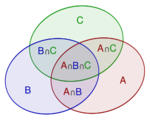AP Statistics Curriculum 2007 Prob Rules
From Socr
(Difference between revisions)
| Line 3: | Line 3: | ||
=== Addition Rule=== | === Addition Rule=== | ||
The probability of a union, also called the [http://en.wikipedia.org/wiki/Inclusion-exclusion_principle Inclusion-Exclusion principle] allows us to compute probabilities of composite events represented as unions (i.e., sums) of simpler events. | The probability of a union, also called the [http://en.wikipedia.org/wiki/Inclusion-exclusion_principle Inclusion-Exclusion principle] allows us to compute probabilities of composite events represented as unions (i.e., sums) of simpler events. | ||
| - | [[Image:500px-Inclusion-exclusion.svg.png|150px|thumbnail|right| [http://upload.wikimedia.org/wikipedia/commons/thumb/4/42/Inclusion-exclusion.svg/180px-Inclusion-exclusion.svg.png | + | [[Image:500px-Inclusion-exclusion.svg.png|150px|thumbnail|right| [http://upload.wikimedia.org/wikipedia/commons/thumb/4/42/Inclusion-exclusion.svg/180px-Inclusion-exclusion.svg.png Venn Diagrams]]] |
| - | Venn Diagrams] ]] | + | |
Revision as of 03:46, 29 January 2008
Contents |
General Advance-Placement (AP) Statistics Curriculum - Probability Theory Rules
Addition Rule
The probability of a union, also called the Inclusion-Exclusion principle allows us to compute probabilities of composite events represented as unions (i.e., sums) of simpler events.
Multiplication Rule
Model Validation
Checking/affirming underlying assumptions.
- TBD
Computational Resources: Internet-based SOCR Tools
- TBD
Examples
Computer simulations and real observed data.
- TBD
Hands-on activities
Step-by-step practice problems.
- TBD
References
- TBD
- SOCR Home page: http://www.socr.ucla.edu
Translate this page:

